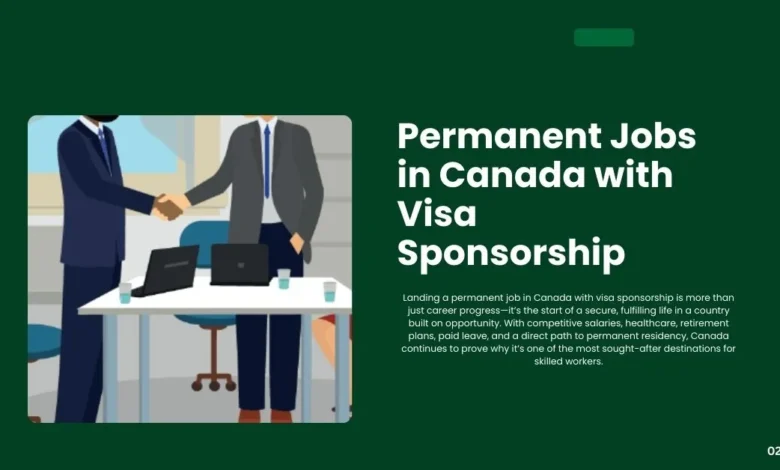Permanent Jobs in Canada with Visa Sponsorship

Imagine building a life in a country that actively welcomes your skills and offers a clear path to long-term stability. For skilled professionals worldwide, securing a permanent job in Canada with visa sponsorship is the key to unlocking this dream.
Driven by a strong economy and significant labour shortages, Canadian employers are not just offering jobs; they are offering careers with competitive salaries ranging from CAD $50,000 to over $120,000 annually, comprehensive benefits, and the invaluable security of visa sponsorship.
The requirements are clear relevant education, professional experience, and language proficiency but the rewards are immense. Beyond the attractive pay, benefits often include healthcare coverage, retirement plans, and paid leave, providing a foundation for a high quality of life. This guide will walk you through the thriving job market, in-demand roles, and the practical steps to turn your ambition into a reality, paving your way to a successful and permanent future in Canada.
Why There is High Demand for Skilled Workers in Canada
Canada’s demand for international talent is a core part of its national strategy, driven by:
- Proactive Immigration Policies: Canada uses immigration as a deliberate tool for economic growth. Programs like Express Entry are designed to attract skilled workers to address long-term demographic challenges.
- Significant Labour Shortages: Beyond general shortages, specific sectors face critical gaps. The government publishes lists of high-demand occupations (like the TEER system under the NOC) to target immigration effectively.
- Aging Population and Retirement Wave: This is a primary driver. As a large segment of the workforce retires, there are not enough young Canadians to fill all the vacancies, creating sustained demand.
- Economic Expansion in Key Sectors: Booming sectors like technology, green energy, and advanced manufacturing require a specialized talent pool that Canada actively sources from globally.
Understanding “Permanent Job” vs. “Permanent Residency”
It’s vital to clarify a key point: A “permanent job offer” is often the critical first step toward obtaining Permanent Residency (PR), which is the ultimate goal for most. There are two main pathways:
- Temporary Work Permit Leading to PR: An employer sponsors you for a closed work permit. After working in Canada for some time, you can then apply for PR through programs like the Canadian Experience Class (CEC).
- Direct Permanent Residency (e.g., Express Entry): A valid job offer from a Canadian employer gives you a significant points boost in the Express Entry system, often making the difference in receiving an Invitation to Apply (ITA) for PR directly.
Salary Expectations
Your salary ranges are a good start. It’s helpful to provide more context:
- Entry-Level Positions: CAD $50,000 – $70,000 is accurate for many fields. However, in high-cost cities like Toronto and Vancouver, salaries at the higher end of this range are more common.
- Experienced Professionals: CAD $70,000 – $120,000 is a realistic band. Senior roles in tech, finance, or specialized engineering can exceed $120,000.
- In-Demand Trades: Certified skilled tradespeople (electricians, welders, plumbers) can earn very competitive salaries, often ranging from $60,000 to over $100,000, depending on experience and specialization.
- Crucial Note: Salaries must meet or exceed the prevailing wage for the occupation in that specific region, as determined by the government for the Labour Market Impact Assessment (LMIA) process.
Requirements
The most important concept for job seekers to understand is the Labour Market Impact Assessment (LMIA).
- What it is: Before hiring a foreign worker, most employers must prove to the Canadian government that no Canadian citizen or permanent resident is available to do the job. This process is the LMIA.
- Why it’s a hurdle: The LMIA process is complex, time-consuming, and costly for the employer. This is why smaller companies are often reluctant to sponsor visas. Large corporations and public sector bodies (hospitals, universities) are more equipped to handle it.
Therefore, the key requirements are:
- A Valid Job Offer from an LMIA-Approved Employer: This is the single most important requirement.
- Educational Credential Assessment (ECA): For PR applications (like Express Entry), you need an ECA to verify that your foreign degree/diploma is equivalent to a Canadian one.
- Language Proficiency: IELTS/CELPIP for English or TEF for French are mandatory. High scores are essential for a competitive Express Entry profile.
- Proof of Funds: For PR applications, you must show you have enough money to support yourself and your family upon arrival in Canada.
Benefits of Permanent Jobs with Sponsorship
- Pathway to Permanent Residency: A job offer is a major asset in a permanent residency application. In many cases, it can grant you significant points in the Comprehensive Ranking System (CRS) for programs like Express Entry, or directly qualify you for a Provincial Nominee Program (PNP) stream.
- Access to Social Services: As a permanent resident or even a worker on a specific visa, you gain access to Canada’s public healthcare system, which covers a wide range of medical services for you and your family.
- Employee Protections: You are entitled to the same labor protections as Canadian citizens and permanent residents, including rights regarding minimum wage, working hours, paid leave, and workplace safety.
- Freedom to Live and Work Anywhere (as a PR): Once you become a permanent resident, you have the freedom to live, work, and study anywhere in Canada, and you are not tied to a single employer.
Visa Requirements for Permanent Jobs with Sponsorship
The process for a permanent job is typically a two-step process: securing a temporary work permit first, and then transitioning to permanent residency. The main visa requirements are:
- A Valid Job Offer: The job offer must be for a full-time, non-seasonal position and must be from a Canadian employer.
- Labour Market Impact Assessment (LMIA): In most cases, your employer will need to obtain a positive LMIA. This document from the Government of Canada proves that the employer was unable to find a Canadian citizen or permanent resident to fill the job.
- Eligibility for an Immigration Program: To gain permanent residency, you must be eligible for a program like the Federal Skilled Worker Program (FSWP), Federal Skilled Trades Program (FSTP), or a Provincial Nominee Program (PNP). Each program has its own specific criteria regarding age, education, work experience, and language proficiency.
- Language Proficiency: You must demonstrate a minimum level of proficiency in English or French by taking an approved language test.
- Credential Recognition: For many professional jobs, you will need to have your foreign educational credentials assessed to ensure they are equivalent to a Canadian credential.
How to Apply For Permanent Jobs in Canada with Visa Sponsorship
Your steps are correct. To significantly improve success, candidates should focus on a strategic approach:
- Target the Right Employers: Prioritize large, established companies, multinational corporations, public healthcare authorities (e.g., provincial health services), and major universities. These organizations have experience with the LMIA and sponsorship process. Research “LMIA-positive employers in Canada.”
- Leverage Express Entry Even Without a Job Offer: Create an Express Entry profile as soon as possible. A high Comprehensive Ranking System (CRS) score can get you an ITA for PR without a job offer. Once you have PR status, finding a job becomes much easier.
- Network Strategically: Use LinkedIn to connect with recruiters and hiring managers in your field in Canada. Join industry-specific groups and participate in online forums. Many jobs are filled through networks, not just public postings.
- Tailor Your Application for the Canadian Market:
- Resume: Keep it concise (2 pages max), focused on achievements and metrics (e.g., “Increased efficiency by 15%”), and remove personal details like age or marital status.
- Cover Letter: Explicitly state your legal right to work in Canada (if applicable) or your interest in visa sponsorship. Address how you can solve the specific employer’s problems.
Conclusion
The pursuit of a permanent job in Canada with visa sponsorship is more than a career move—it’s an investment in a stable and prosperous future. Canada’s deliberate and welcoming immigration system, combined with genuine economic needs across critical industries, creates a unique environment where international talent is not just needed but valued.
From the high standards of patient care to the innovation driving its tech sector, Canada offers a chance to build a meaningful career while enjoying a high quality of life. By understanding the requirements, tailoring your application, and strategically navigating the immigration pathways, you can successfully secure your place in one of the world’s most diverse and opportunity-rich nations. Your future in Canada awaits.
Frequently Asked Questions
-
Do I need to have my educational credentials assessed?
For many professions, especially regulated ones like engineering or nursing, you will need an Educational Credential Assessment (ECA) to verify that your foreign degree is equivalent to a Canadian one. This is also a requirement for most permanent residency programs.
-
Which provinces in Canada have the most job opportunities?
Ontario, British Columbia, and Alberta have the highest number of job openings, particularly in major cities like Toronto, Vancouver, and Calgary. However, provinces like Saskatchewan, Manitoba, and the Atlantic provinces have specific immigration programs to attract talent to their regions.



